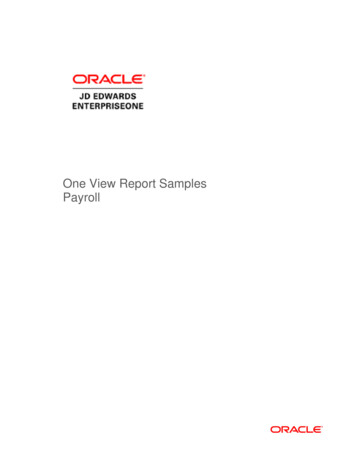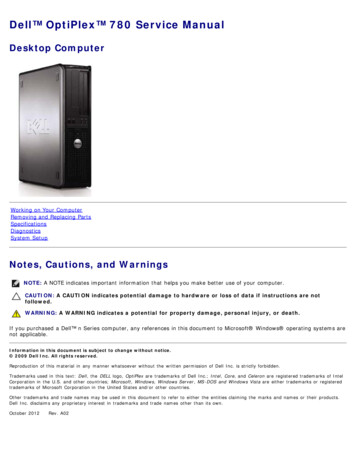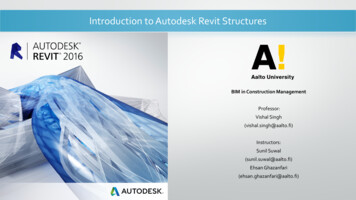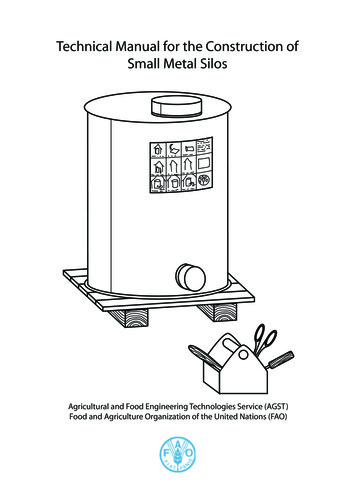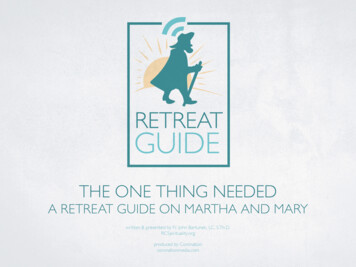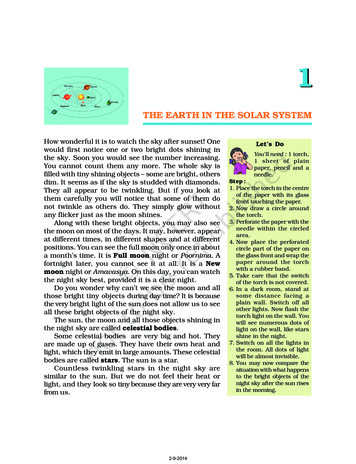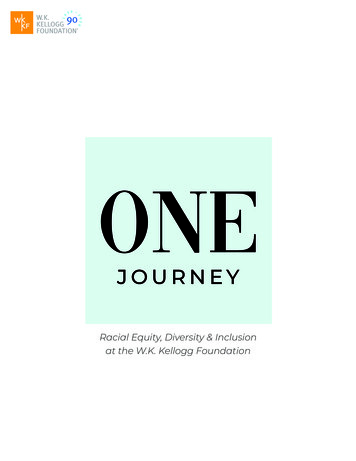
Transcription
ONEJOURNEYRacial Equity, Diversity & Inclusionat the W.K. Kellogg Foundation
TABLE OFCONTENTS24Our Pursuit of Racial Equity7A Shared Commitment to Children8WKKF’s Racial Equity Journey12Our DNA Theory of Change15How We Define Racial Equity18Board Leadership & Vision20Senior Leadership Commitment23Staff DevelopmentPractices & Processes28Affinity Groups30Investment Team Leadership33Pathways for Action3
OUR PURSUIT OFRACIAL EQUITYA LE T TER FROM LA JUNE MONTGOMERY TABRONPRESIDENT & CEO, W.K. KELLOGG FOUNDATIONThis guide is intended for foundations, nonprofitorganizations, human resource professionals and anyindividual or organization looking to advance racialequity. In the sections that follow, we offer insightinto our own racial equity journey as a resource foryours. We want to give you a better sense of the roleof board leadership; how we approached reviews ofinternal policies and practices; and how and wherewe leverage our networks, research and voice.Whether you are exploring this related to your service– on a board of directors, as a member of seniorleadership, as a human resources professional – oras an individual seeking to help your organizationadvance toward racial equity, this guide is for you.Tvalues and every aspect of our work.Coming to understand differences withinour organization helps us to understand howdifferences play out in communities. We’re strivingto practice and pursue the challenges we’re askingothers to undertake.Racial equity. Diversity. Inclusion. These termsrequire practical application – on both individualand organizational levels. Lasting transformationbegins with people. And we all have a leadershiprole to play.Personally, I want people to see me as someonewho is open to all feedback and perspectives, whohe foundation’s journey toward racial equity,diversity and inclusion has been a complexone extending over decades. And we’restill not there yet. But when I look at what we’veaccomplished since I joined the foundation in 1987,embraces differences rather than shying awayfrom them. I look for ways to get people to open“We’re striving to practice andup lines of conversation and build relationships.Ours is an inside-out approach – building on theIt’s okay if we have a moment where everythingfoundation’s deep commitment to racial equitydoesn’t go smoothly; that’s a learning opportunity.and always coming back to children as our focus.We continually try new approaches, learn fromIn my leadership role at the W.K. Kelloggthese attempts and use those findings to honeFoundation, my goal is that every person feelsstrategy and align our work.valued and engaged in our work. The onlyway to get to this place is to continue buildingAs you will see, there is no single path. But wean environment that can truly hold all of ourinvite you to consider how we are pursuing racialAs an organization, our engagement in racialpursue the challenges we’reasking others to undertake.differences and keep each person whole. That’sequity in the hope that lessons from our effortsequity, diversity and inclusion extends from ourwhat we’re working toward – and we’re going toover time will speed your progress.– La June Montgomery Tabronget there.board to staff, partners, vendors and grantees.I’m proud of the alignment we’ve achieved“the progress is remarkable.4between the Kellogg Foundation’s mission andMany thanks for your interest in our journey. Welook forward to learning about yours.5
A SHAREDCOMMITMENTTO CHILDRENFor the W.K. Kellogg Foundation (WKKF), ourWe know that pursuing racial equity fostersfocus has always been children. But we knowstronger relationships and partnerships that willthat children live in families and familieslead to what we desire: thriving children, workinglive in communities. For children to thrive, theirfamilies and equitable communities.families need to be able to provide for them andtheir communities need to be equitable placesof opportunity.Yet too many communities are not places ofThe nation’s unfinishedequitable opportunity in our society, as ourmission is reaching hearts,grantees and partners know. Based on decades ofminds and souls so thatprogramming, we recognized that racism is theracial equity can be broadlychildren thriving.Any journey toward racial equity, diversity andinclusion is a long one. At the Kellogg Foundation,we approach it as an essential learning journey –one we commit to on behalf of children.Our willingness to stay the course, even when it’sdifficult, is connected to this shared commitment.embraced by the majorityof the population, and theprevalent belief in racialhierarchy is at last overcome.– La June Montgomery Tabron“root cause – and a primary obstacle to all6“7
WKKF’S RACIALEQUITY JOURNEYOur journey to advance racial equity isand affirm the value of each person’s contributionbest understood with a closer look at ourin shaping society.history and evolution as an organization.In 1930, when Mr. Kellogg established ourFrom his legacy came these intersectingfoundation to promote “the health, happiness andapproaches — racial equity, communitywell-being of children,” he did so mindful of theengagement and leadership. We call them ourinterconnections between children, families andDNA because they are integral to everything wetheir communities. In order to change children’sundertake and interwoven into all of our work onlives for the better, community members had tobehalf of children.come together, recognize their power to leadANTI-RACISM IS PART OFOUR FOUNDER’S AND OURHOMETOWN’S HISTORYThe Kellogg Foundation’s hometown of BattleCreek has historically been deeply committedto the struggle for human and civil rights. Inthe 1850s, the site of our current headquarterswas home to a safe house on the UndergroundRailroad, a place where more than 1,500 enslaved8Our founder, Will Keith Kellogg, was the son ofpeople found sanctuary on their way to Canada.abolitionists who often sheltered enslaved AfricansBattle Creek was also the home of Sojourner Truth,fleeing to Canada. He was raised an observantone of the most prominent abolitionists of themember of the Seventh Day Adventist Church,19th century. The Kellogg Foundation honored thiswhose co-founder – Ellen G. White – opposedlegacy in 1993 when it helped to fund the nation’sracism in any form.largest monument to the Underground Railroad.9
“Our DNA is the lensthrough which we viewall of our work. It is atthe intersection of racialequity, communityengagement andleadership that lastingoutcomes for childrenare achieved.– Rick Tsoumas,trustee, WKKFThe alignment with our mission and vision hasmade the commitment to racial equity, diversityEVOLVING TO AN INSIDE-OUT APPROACHand inclusion – in both grantmaking and internaldecision-making – broad and deep. It touchesevery aspect of our work and every relationship.It is evident and important as we work alongsidegrantee organizations based in local communitiesand with national partners. Our clear commitmentto racial equity, diversity and inclusion is ameaningful indicator of what we are striving for asan organization and the kinds of organizations weseek to support.Our commitment is also a signal and catalystto staff. Individually each person is on a journey;together, we are on a shared, organizationaljourney. The clarity of our focus encourages staff inboth operational and programming areas to work“in the most culturally responsive ways possible toThe Kellogg Foundation has been makingachieve our mission.investments to advance economic equity sinceits inception in 1930. In the 1940s, we beganof racial inequity in health care professions servingU.S. hospitals. This was the beginning of ourprogrammatic work, and it has evolved over time.In these and other programming efforts, welearned that for institutions to tackle racial equity,they needed to do internal work first. We started tolook at the Kellogg Foundation from that lens – tosee where we needed to change, starting with ourown diversity and inclusion efforts. That was thebeginning of our own journey.When WKKF’s Board of Trustees committedthe foundation to being “an effective anti-racistorganization that promotes racial equity,” webegan to utilize every available tool and resource,and leverage every internal decision pointand policy toward the common goal of advancingracial equity from the inside-out.10“Having racial equityembedded and woventhrough all of thoseprograms and processeshelps to infuse it inthe culture, in thevocabulary, in everythingthat we do.– Dianna Langenburgvice president for talent andhuman resources, WKKF“making grants to dismantle the crippling effectsIn 2020 WKKF launched a White Allies group to create space for introspection, exploration andaction. The group fosters a supportive environment for employees to stand in solidarity withtheir colleagues of color and lean into truthful, difficult and uncomfortable conversations aboutthe factual history of race, racial identity, White privilege, racial hierarchy and its impact on oursociety and our work as a foundation.11
OUR DNA THEORYOF CHANGEIn 2018, WKKF conducted an analysis toBased on this, team members created theunderstand the feelings, needs and motivationsKellogg Foundation’s DNA Theory of Change,of employees to identify how our work in racialwhich is comprised of racial equity, communityequity, community engagement and leadershipengagement and leadership working together asshows up in people’s day-to-day lives, as well ascomplementary approaches in achieving equitableto curate and create new products andoutcomes where all children can thrive regardlessdelivery methods.of their race/ethnicity, or socio-economic status.It is at the intersection of each approach thatstrategic outcomes are achieved.At the intersection of communityengagement and racial equity, a sharedvision of communities that marshal theirresources to assure that all children havean equitable and promising future iscreated.At the intersection of racial equity andleadership, an authorizing environmentis created for this shared vision todevelop into a mission of strengtheningand creating the conditions that propelchildren to achieve success as individualsand as contributors to the largercommunity and society.12At the intersection of leadership andPolicies and structures reinforce andcommunity engagement, a culture andsustain these outcomes and provide aset of behaviors are nurtured that promoteshared vision of the future and ancollective leadership, rigorous and strategicenvironment that creates space forthinking, child-centric measures of successprogress toward a community’s goals,and a compassionate environment thatand its culture and behaviors.allows all staff to express their humanity.13
HOW WE DEFINERACIAL EQUITYOur evolution as a learning organizationhas allowed us to continue our racialequity journey. Over time we havedeveloped a clear set of definitions, goals,activities and outcomes—based on our theoryThe Kellogg Foundation’sracial equity journeyof change— that provides the north star forcontains the story of whoour journey.we are, where we comeThe racial equity work of the Kellogg Foundation isfrom and the potential fordesigned to challenge and dismantle racism in allour future. As part of ourforms; support racial healing; identify and addressDNA, it informs our beliefs,historic oppression and privilege; remove presentday barriers to equal opportunities; and interruptrelationships, day-to-daythe racialization process in which people andinteractions and decision-institutions operate. We do this through a series ofmaking processes.goals and activities, with a clear set of outcomeswe seek to achieve – all toward racial equity.1415
WHAT IS RACIAL EQUITY?WHAT IS RACIAL HEALING?Racial equity is an aspirational pursuitRacial healing is a process that restoresinsisting that all people, regardless ofindividuals and communities to wholeness,their racial/ethnic group identification,repairs the damage caused by racism andskin color or physical traits, will have equaltransforms societal structures into onesopportunity to experience well-being in athat affirm the inherent value of all people.just society. Achieving racial equity meansThis process provides an opportunity tothat an individual’s identity would not beacknowledge and speak the truth aboutpredictive of their day-to-day experiences orpast wrongs created by individual andtheir life outcomes. Racial equity is a two-systemic racism and addresses present-strand approach that focuses on systemsday consequences for people, communitiestransformation and racial healing. The socialand institutions. Racial healing on internal,construct of race has been used to sustainintragroup and intergroups levels area false hierarchy of human value that favorssupported through: respectful dialogue;some racial groups over others (privilegingrecognition and affirmation of people and“Whiteness”) and determines access totheir experiences; connectedness to one’sresources and opportunities.cultural ways and practices; and the senseof agency nurtured through racial justiceactivism and organizing.RACIAL EQUITY VALUES IN ACTIONIn work with communities, we:include people of color as leaders, experts and researchers. We are careful not to allowgroups to study communities of color without establishing trusted relationships;invite community residents to participate and shape outcomes;invest in collaboration across multi-sectors, including business, governmentand nonprofit sectors and promote cooperative planning processes.1617
BOARD LEADERSHIP& VISIONThe Kellogg Foundation’s advancementand tell people what they need. Rather, we listen toof racial equity could not have happenedlearn the community’s priorities. Unless we includewithout the board of trustees’ explicitand respect the authentic perspectives and voicescommitment and leadership. For most of theof the communities with which we work and serve,foundation’s history, the board was composedwe won’t be successful.primarily of White men, with the exception of onewoman, Bessie Rogers Young, in the foundation’sThis is true of our work in communities and alsoearliest years (1933-1955). In 1980, under Presidenttrue of the composition of our board. In order toRuss Mawby’s leadership, the foundation beganbe most effective, our board’s composition mustto diversify, recognizing that greater diversityreflect the communities in which we serve.would make for a more effective organization.Diversity efforts began with gender and expandedto include age, race, ethnicity, geography, lifeexperience and more.The board of trustees continues to pursue the workequity as a critical componentbegun by W.K. Kellogg and sees its contributionsof our work in 2007, it wasas part of his lasting legacy and enduring vision.considered bold and courageous.Embracing diversity, inclusion, racial equity andBut it was important because itorganization are consistent with our values and theintent to improve children’s lives.In that pursuit, we seek to better represent andunderstand the communities we serve. It’s not forus as a private foundation to go into a communitygave our staff and partners theconfidence to be very intentional.– Celeste A. Clark,board chair, WKKF“declaring the Kellogg Foundation an anti-racist18“When we first identified racialBOARD DIVERSITY CHANGEIn 1984, the board was 10 people – nine White and one Person of Color; nine men andone woman.In January 2014, the foundation appointed its first female and African American CEO,La June Montgomery Tabron.In 2019, the Kellogg Foundation staff was 45% People of Color.In 2020, of our nine trustees, six are People of Color and three White. Of the People of Colorthere are four African Americans, one Latino and one Asian American.In 2020, of the Kellogg Foundation’s executive leadership team, 42% are People of Color (5 of 12)19
SENIORLEADERSHIPCOMMITMENTOur senior leaders demonstrate apersonal commitment to racial equity,systems. Individually, each leader has committed“Racial healing is anto his or her own personal growth by participatingimportant part ofdiversity and inclusion by articulatingthe foundation’s goals, strategies, policies andin intensive learning labs, as well as team andindividual coaching.For several executive leaders, the work of racialequity, diversity and inclusion is a personalpassion and a significant part of their professionalIt includes everyone. Asa White man who hasbenefited from privilege,accomplishments. They are recognized as leadersI also have a crucial rolein the field and speak nationally and internationallyin this process. This is notleadership and the foundation as a whole benefitfrom their insight and expertise.As a relatively small organization with a tightly knitcommunity, our staff have frequent opportunitiesto engage with leaders. Foundation employeeslook to leaders to be role models in our pursuit ofracial equity. When employees see that leaders actin accordance with our commitment to advanceracial equity and create and maintain an inclusiveculture, it builds trust and inspires employees todo the same.WHAT WE HAVE LEARNED:a journey just for peopleStart your own journey.of diverse backgrounds.Learning about unconscious bias is a good firstTake concrete action withinyour organization.step. That helps expose the microaggressionsAs leaders, you must drive internal processesthat affect people of color in organizations. Theseto have a diverse candidate pool, hire the bestThis is a journey for all ofus – and it’s a hard, butfactors play a critical role in attracting and—morecandidates of all backgrounds and then establishincredible one.importantly—the retention of employees of color.- Joel Wittenberg,vice president and chiefinvestment officer, WKKFBe humble.employees. This level of personal commitmentEngage colleagues of color and ask what it’s like toto advancing racial equity is energizing andwork at your organization. It seems simple, but thishas the ability to drive your organization’sis a very powerful exercise that can contribute tolong-term success.“on philanthropy and racial equity. Our entire20achieving racial equity.a structure to fairly evaluate and promoterelationships based on trust.21
STAFF DEVELOPMENTPRACTICES ANDPROCESSESSimilar to board composition, our humanensuring diverse search firm partners and diverseresources team takes the same approach tofinalist pools. We build staff awareness andhiring and developing staff. We aim to buildsupport consistent, ongoing learning. And, wea culture and work environment that supportscontinually evaluate our efforts while reportingracial equity. We have specific goals related toannual benchmark data externally.talent acquisition and workforce representation,INTERNAL EFFORTS2223
We do this because we cannot serve communitiesof color if we don’t have people on staff and in“Racial equity is not apassive effort at theKellogg Foundation.We strive to embedit in everything wedo. It stems from adeep commitment tofundamentally changethe belief systems andstructural barrierscreated by a falsehierarchy of humanvalue. It’s the mainthe people in the communities we serve. Hiring,developing and retaining a diverse workforcehas been an important pillar of our recruitmentstrategy for decades. Only by “walking the talk” willwe achieve our aspirations.The Kellogg Foundation’s commitment to racialequity begins with the recruitment phase.From reading job descriptions, to preparingan application, to the first conversation witha recruiter, potential candidates are given anopportunity to envision themselves as part ofa workplace where racial equity and healing,leadership development and communityengagement are embedded practices.WKKF EMPLOYEEVALUE PROPOSITIONAt the W.K. Kellogg Foundation, you join acollaborative team committed to children.Together we contribute to creating a worldwhere children can thrive.At the W.K. Kellogg Foundation:We commit to racial equity. We infuse racialequity, community engagement and leadershipinto all our work and we partner with organizationsand communities working to create equitableopportunities for the families and communitiesWe value different perspectives. We affirm oneanother’s humanity. We respect, leverage andcelebrate the diverse perspectives of people.We adapt continuously. We strive forimprovement, foster a flexible and agile culturethat values team results, and places high emphasison providing great service to our grantees, vendorsand to one another.We invest in people. We develop the skills andcapabilities needed to create leaders at every levelof our organization and we place decision-makingauthority to those closest to the work.we serve.In fact, it’s the basis of the WKKF Employee ValueProposition—the promise we make to candidatesand new employees that they will be joining acollaborative team committed to children, wherereason I joinedracial equity is infused into all of our work andand working with our teams to identifycomposition for more than a decade, and wethe foundation.where we continuously strive to improve.internship and equitable leadership developmentwere one of the first foundations to publicly postopportunities ensure a racially diverse staff atemployee and trustee demographics on our- Vicky Stott,program officer, WKKFOur standard is that the only viable candidateall levels. At the same time, we routinely reviewexternal website. Over the past decade our staffpool – for any position – is a diverse candidatepromotions and compensation levels tocomposition has changed from 24% to 45% peoplepool. We’ve partnered with hiring managersensure equity.of color, a 112% increase. Additionally, our executive“24leadership positions making decisions who reflectleadership has increased from 27% to 42% over theand recruiters to ensure diverse outreach andshare accountability for meeting this standard.The trends have been consistently positive. WeCollaboration with temporary staffing agencieshave been measuring and reporting workforcelast 10 years.25
Once on staff, each team member plays a role inWe also strive to create and sustain a diverse,ensuring our workplace culture is one where staffinclusive and equitable workplace in which allmembers of all racial and cultural backgroundsemployees have the opportunity to succeed.can bring their full selves to the office and to ourBy creating a safe and courageous space forshared work. Our onboarding practices equip newawareness and development activities, westaff to become co-creators of this culture. Withinprovide our staff with a set of tools, commonthe first few weeks of employment, staff takelanguage and experiences related to racial equity,the Intercultural Development Inventory, whichcommunity engagement and leadership forprovides information and an opportunity to assessindividual and collective learning and growth.individual ability to appropriately adapt to culturalIt’s not about everyone thinking the same thing,differences. They are also matched with a coach toit’s about appreciating and understanding manymap out plans for further development of theseperspectives and learning from them – ultimately,intercultural competencies.enabling us to affirm one another’s humanity.WHAT WE HAVE LEARNED:Leadership support is critical.this connection, however everyone is different.Our board made its formal commitment to WKKFWhat touches one person, might affect anotherbeing an anti-racist organization in 2007. Althoughwe had worked to advance racial equity for manyyears prior, this was a defining moment for us to bePatience and perseverance are key.intentional with all our efforts from the inside-out.Sometimes you feel as if you’ve taken two stepsforward and one step back. Or one step forwardLanguage and words matter.and two steps back. We’ve been there too. WhenWe have learned that certain words, phrases andwe started our internal journey we implementedconcepts have racist roots and we are mindfulIn fiscal year 2019/20, 60% of internal promotions werepeople of color. The turnover rate for people of color overthe last five years is at 12%, lower than the reported levelsof peer foundations.not to use them. We also work to educate ourcolleagues when the origins of language are notunderstood more broadly. We foster a culture ofawareness efforts that were not well receivedand ultimately created hurt feelings among ourWhite staff members, which in turn led them todisengage. This was a real setback and a pivotalgrowth, development and humility.learning moment for us.One size does not fit all.Accept that everyone maynot commit.Every organization, person and journey isdifferent. One of the things we’ve learned is thatWKKF WORKFORCE COMPOSITIONdifferently for various reasons.to advance racial equity most effectively, therehas to be a connection between the head andthe heart. Sharing personal stories helps makeEven if it feels like you are making great progress,you still may not get everybody on board. Youhave to find a way to live with that tension, respectwhere everyone is and help everyone feel valued.MEETINGS AND VENDORS26Our practices related to racial equity extend tounless part of an educational experience; weour interactions with vendors and all aspects ofopen meetings with a land acknowledgementmeeting planning. When the Kellogg Foundationrecognizing the Indigenous people of that region;hosts an event, convening or meeting, we vet ourand we look into the diversity, equity and inclusionvendors’ racial equity standards. For instance, wepractices of hotels, such as inquiring whetherdo not rent venues that were former plantations,service charges are distributed among staff.27
AFFINITY GROUPSAffinity groups are a big part of theOffer leadership development andWKKF journey. Our human resourceopportunities for advancement throughprofessionals know the key componentonboarding and peer mentoring, skill-to the recruitment and retention of WKKF staff ofbuilding exercises and specific culturalcolor has been our long-standing affinity groups.and/or heritage celebrations and recognition.Building on the foundation’s commitment to racialequity, community engagement and leadership,Foster community participation andthe goal of WKKF’s affinity groups is to promotepresence for equity through alliance-buildingand honor the wisdom, experiences and historiesacross affinity groups and communities.of people of color while catalyzing individual andcollective transformation.addresses various forms of privilege and promotesracial healing to dismantle racism and othering –fully embodying our commitment as ananti-racist organization.Affinity GroupsPromote cultural knowledge andsocial understanding through various,foundation-wide learning opportunities likeheritage month events, dialogue aroundcurrent events or cultural activities.“RAÍCES has provided a safespace for me to connect withothers who share aspects ofmy identity, and has given metools to be more inclusive inmy work and the confidenceto show up as who I am.”- Emma Brecheisen,concierge service associate, WKKF“We create an organizational culture thatWHAT WE HAVE LEARNED:Affinity groups have a journey.At times, affinity groups have dwindled inparticipation and have had challenges with clarityof purpose. However, when we are clear aboutintent and engagement strategies, the groupsrecommendations and policies that ensureretention and development of staff. They alsoplay a critical role in the talent development ofemployees of color.their contributions to staff culture and learningAffinity groups shapeorganizational culture.are significant.Ultimately, affinity groups help the organizationare well-positioned and supported with resources,grow in its commitment to racial equity, becauseAffinity groups help develop talent.of the wisdom, knowledge and professional andOrganizational affinity groups provide anlived experience they bring to the organization.important avenue for employees of color to share2829
INVESTMENTTEAM LEADERSHIPIn the financial sector, very few investment teamsIn addition to our mission driven investments,include many people of color. In communities,and with board support, we began our pursuitthat translates into little or no access to qualityto find more diverse investment managers injobs or capital for entrepreneurs of color and the2010. Over time we have tried a number of tactics.organizations or businesses they lead. RecognizingWe invested more than 100 million from ourthese dynamics, we considered how to address in aendowment in diverse-owned firms to develop thesystematic way through our own efforts – totalent pipeline and advance racial equity in thealign this aspect of our work with ourinvestment industry.Most recently, we are engaging institutionalfirms change from the inside-out. Working with ainvestors interested in improving their internalcohort of leading investment management firms,processes to widen equity in their organizationswe are developing and implementing tools andand positively influence the ecosystem. In 2019 wetechniques to help organizations more activelylaunched our Expanding Equity program – to helppursue equity within their companies.organizational commitment.have been to address capital market gaps in asystematic and comprehensive way – to widenaccess to capital for people of color and to addressthe unconscious bias and racism supportingthe status quo.In 2007, with the board’s leadership, we committed 100 million of our endowment to market-rate,mission-related investments to disrupt the statusquo and drive capital to communities of color. Andlike many foundations, we also leveraged programrelated investments. From our program’s inception,we have deployed more than 200 million inmission-related and program-related investments.30“Our mission requires everyavailable tool. In additionto grantmaking, WKKFattempts to harnessthe power of the capitalmarkets to improve the livesof children, their familiesand their communities.– Cynthia Muller,directo
Any journey toward racial equity, diversity and inclusion is a long one. At the Kellogg Foundation, we approach it as an essential learning journey - one we commit to on behalf of children. Our willingness to stay the course, even when it's difficult, is connected to this shared commitment. A SHARED COMMITMENT TO CHILDREN


